A gemstone is a solid rock or another valuable material for different reasons. Gems are found in various minerals, but their scarcity, durability, and beauty make them highly treasured. Gems can be cut and brightened to be used by humans and different advancements. Some of the gems are found in sedimentary rocks. There are geological processes that result in the formation of sedimentary rocks. These processes are weathering, erosion, lithification, dissolution, decay, disintegration, and precipitation. When these processes happen, stones are left exposed on or near the earth’s surface. These rocks are worn down, and particles rich in water and wind minerals seep into cavities and cracks in the surface of the earth, depositing those minerals in layers. Animal and plant remains are embodied among the rock particles, and these can be upheld as fossils. Over time, these minerals are compressed, resulting in the formation of gemstones.
Nature of occurrence of gemstones in sedimentary rocks
Rocks and minerals formation via the sedimentary cycle is the second largest process. Sedimentary rocks are processes of wind, rivers, ice erosion, transportation, and deposition of materials. These processes involve the decay and dissolution of already existing masses of rocks. Commonly, new minerals are found but have yet to be formed. Alluvial gravels, clays, or sands are formed when the particles from rock masses settle. When these alluvial gravels, clays, or sands are compressed, they form limestone, conglomerations, and sandstone sedimentary rocks. Some material dissolves in water due to chemical action in the surrounding. In the end, the water will be exposed to heat, making it evaporate, and the remains of borax and other salts will be formed this way. Most gems are mainly found in alluvial deposits. The deposits originated from the destruction of the initial rocks and the resultant materials by glacial movement, rivers, and floods. Heavier materials are transported only a short distance from their sources during the movement. In contrast, lighter materials are taken far away. These heavy and hard materials resist wear as much as light ones and usually tend to maintain their original crystal shape. However, due to repeated and continuous disintegrating and rolling for an extended period, most gemstone minerals are found as circular or oval water-worn pebbles. Many of these minerals are found in gem gravels of Sri Lanka. Many diamond gems survive the sedimentary processes due to their higher density and matchless hardness; hence they are often found in alluvial deposits.
List of gemstones found in sedimentary rocks
1. Beryl

Beryl is a comparable scarce silicate mineral denoted as Be3Al2S6O18. In many regions of the world, it is found in igneous and metamorphic rocks. It contains a measurable amount of beryllium which is a scarce metal. The rarely found beryllium metal limits beryl formation since it forms where it is present in enough amounts to include minerals. In sedimentary rocks, beryl is found where carbonaceous shale, marble, and limestone have been deposited and compressed in sediments. Beryl can be classified as emerald, aquamarine, morganite, etc. Its color determines where it will be classified. The saturation of color and quality enormously impacts the value of beryl. The gem has different colors, such as green, yellow, pink, red, colorless, etc. Its Mohs hardness ranges from 7,5 to 8, and its specific gravity is 2.6 to 2.8. Beryl has imperfect cleavage. It is mainly used as a gemstone and a minor ore of beryllium.
2. Opal
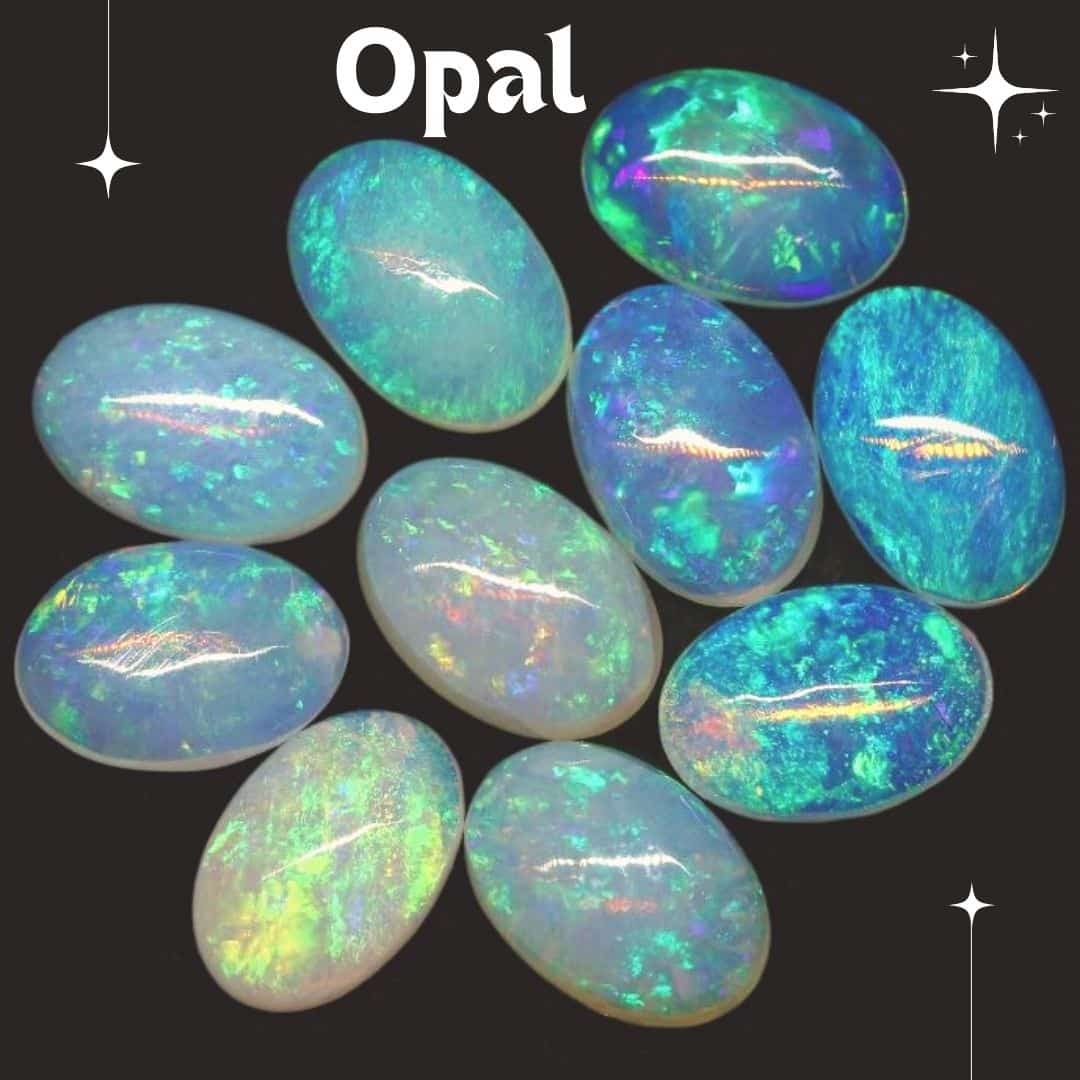
Opal is hydrated silica. It is chemically represented as SiO2.Nh2O. The water content in opal varies between 2 and 20%. Other opals, e.g., precious opals, contain water varying from 6-10%. Opal is of three types, i.e., solid, matrix, and boulder. Boulder opal is formed due to ionization in sedimentary deposits, which are later compressed together. Opal has varying hardness due to varying silica, aluminum, iron, and water compositions. Boulder opal is connected to the rock containing iron, and the stones are commonly cut with the ordinal ironstone supporting intact. Solid opals can be shaped from ironstone material with a sufficient opal thickness. Opals are cut to equal sizes and shapes and can also be fashioned in irregular shapes to display beautiful appearances and avoid wastage. Opal is found in white, brown, gray, or yellow colors. Precious opals have green, red, orange, blue, and violet colors. Opal Mohs hardness and specific gravity are 5 to 6 and 2 to 2.2, respectively. It is brittle due to the water content in it. Opals are used as ceramic ingredients, abrasives, fillers, insulation media, ornament stones, and a gem.
3. Quartz

When silicon and oxygen react, the resultant mineral is quartz. Its chemical composition is SiO2. It is the second most found mineral in the earth’s crust. It is known to be resistant to both physical and chemical weathering. When a rock is exposed to weathering, the remains material typically contains quartz. In environments prone to sediments, shells of silicious organisms accumulate to form siliceous stones, which during diagenesis, they form quartz. Quartz is durable and hence found in beaches, rivers, mountaintops, and desert sand. It occurs in many colors, such as gray, yellow, brown, green, pink, red, purple, etc. Quartz Mohs hardness and specific gravity are 7 and 2.6 to 2.7, respectively. Quartz is an admirable gemstone. It is known to have a shiny finish and is hard and durable. Widely used varieties of quartz are rose quartz, aventurine, citrine, smoky, and amethyst. Quartz is used as gemstones and abrasives for glass making, hydraulic fracturing proppant, and foundry sand.
4. Turquoise
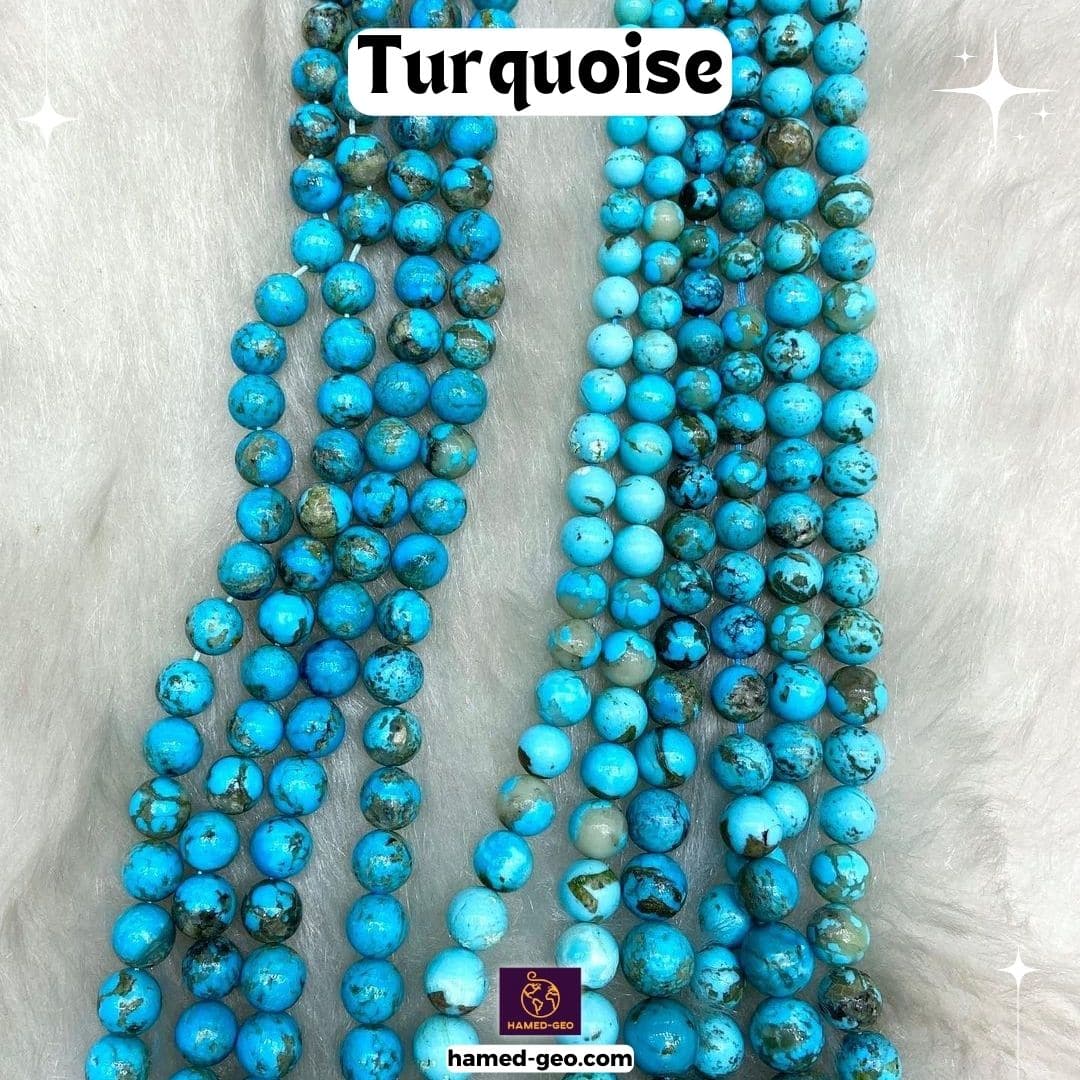
Turquoise is a frosty mineral found in different beautiful shades such as yellowish green, bluish green, blue and green. It contains metals such as copper and aluminum, and its chemical formula is CuAl6(PO4)4(OH)8·4H2O. When surface runoff infiltrates the earth through soil and cracks, it dissolves a measurable amount of copper. Later, the water evaporates, leaving copper to combine with phosphorus and aluminum to produce small amounts of turquoise. When several layers piles together, they are compressed by overlying material to form a solid mass of turquoise. Turquoise has Mohs hardness ranging from 5 to 6 and specific gravity of 2.5 to 2.9. It is found as a microcrystal aggregate, and when packed closely, its porosity is lowered, becomes durable, and can be polished to a higher luster. Turquoise is used as a gemstone, decorative, and small sculptures, among other uses.
5. Malachite
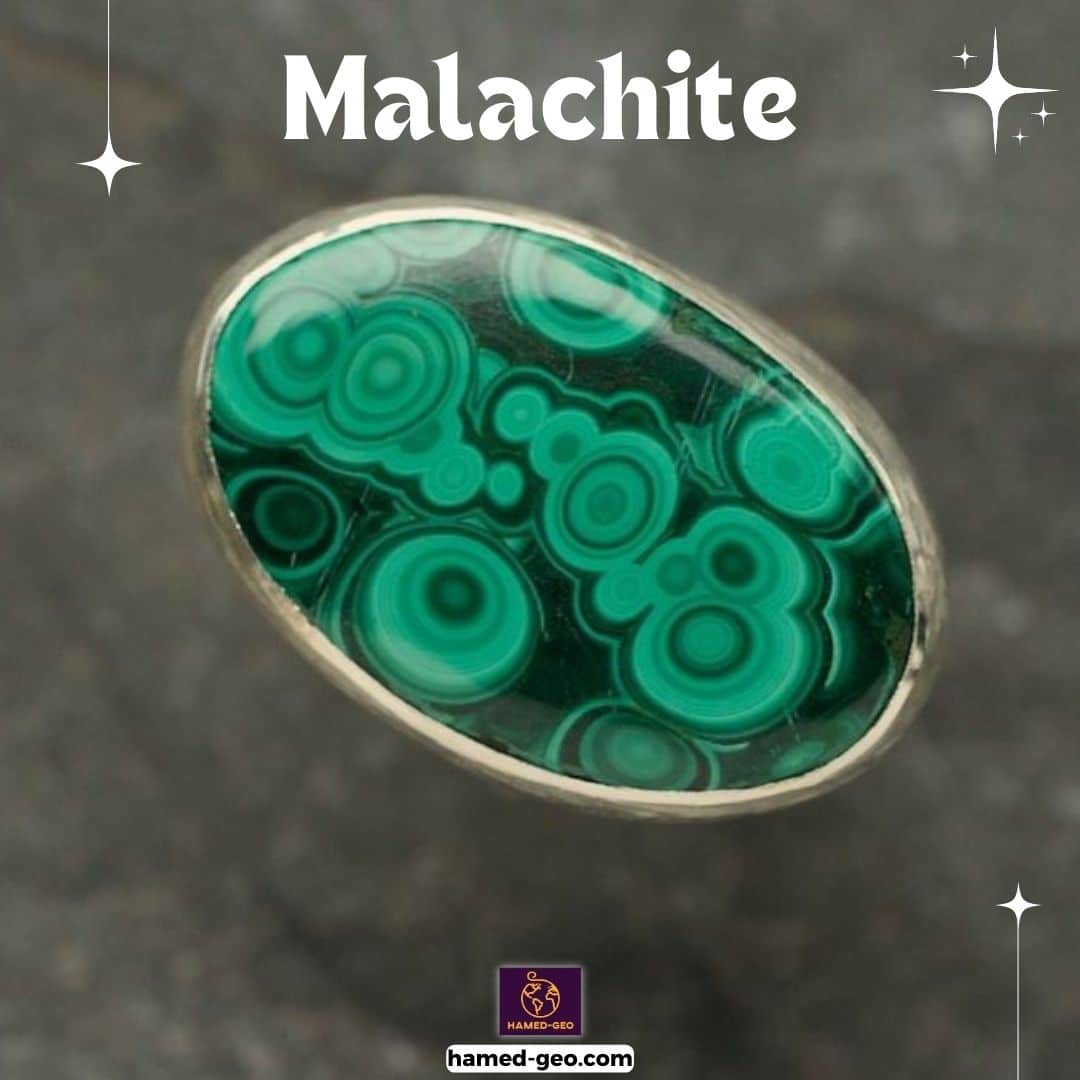
Malachite is a mineral formed due to copper, carbonate, and water react. It has a chemical formula as Cu2(CO3)(OH)2. It is green in color. It does not fade when exposed to sunshine or light over a while. The mineral is formed at a small depth inside the earth where copper has been deposited. The depth in which copper deposit is found contains oxygen, hence copper oxidation. The oxidized copper precipitates when solutions in cracks, cavities, and caverns descend. Repeated piling of layers results in the compression of sediments forming layers of gemstone known as malachite. Malachite has perfect cleavage in one direction. Its Mohs hardness ranges from 3.5 to 4.0, while its specific gravity is 3.6 to 4.0. in ancient times, malachite was used in copper. Nowadays, it is used as gemstones, a minor ore of copper, pigment, and small sculptures.
6. Azurite
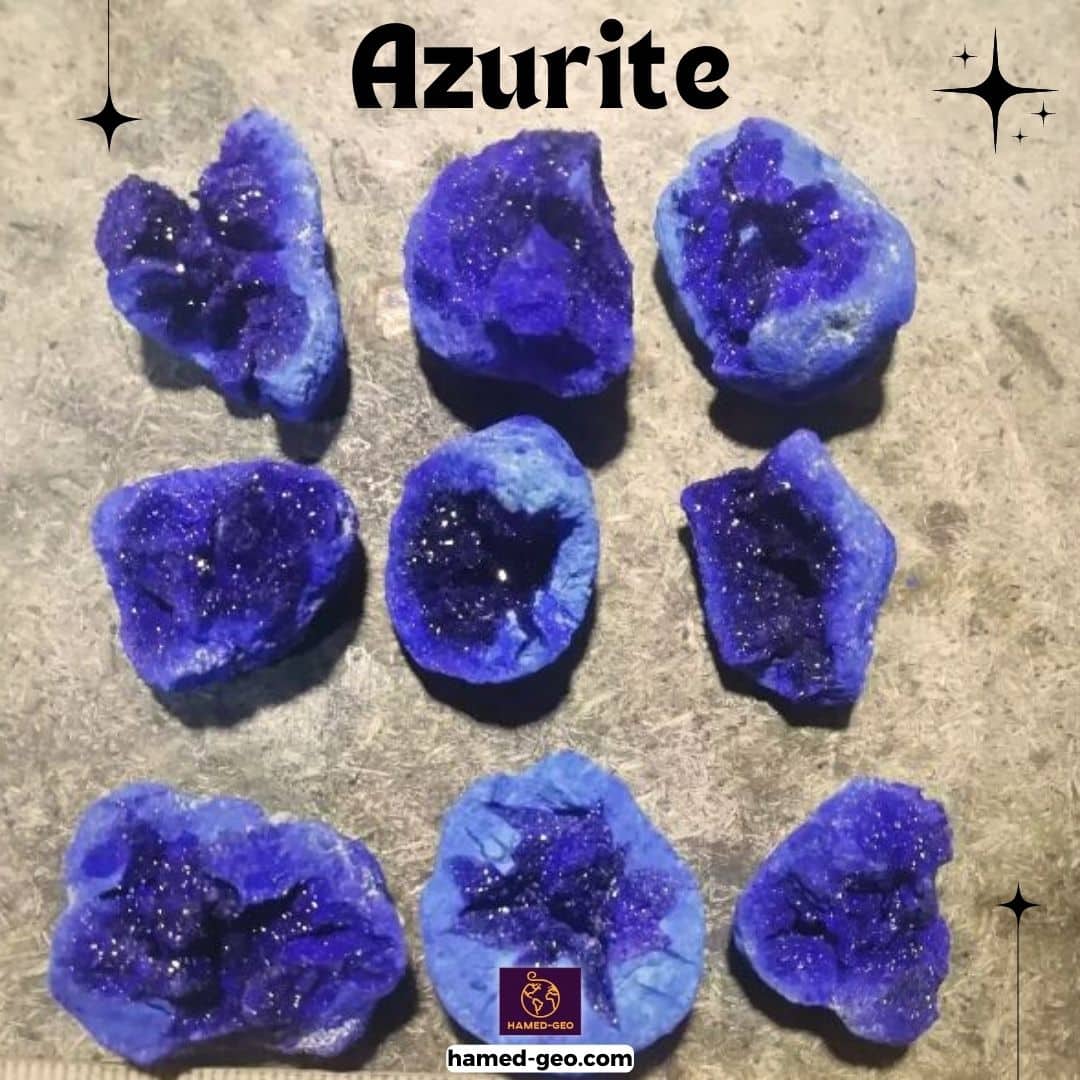
When carbonated water descends into the earth, they react with copper ores in the subsurface. Small amounts of copper dissolve in carbonic acid, which is transported in the solution until it reaches a new geological environment with new chemicals. In this new environment, evaporation occurs with the right water and temperature, and azurite minerals may form. If this process repeats for a long period, more accumulation of mineral azurite develops. Its chemical formulae is Cu3(CO3)2(OH)2. Azurite has deep blue to violet blue. Its cleavage has two directions, perfect and poor, with Mohs hardness of 3.5 to 4 and specific gravity of 3.7 to 3.9. azurite can be massive or nodular depending on cracks, cavities, and pore spaces where it is formed. It is used as a gemstone, an ore of copper, pigment, jewelry, and ornament stone.
7. Chrysoprase
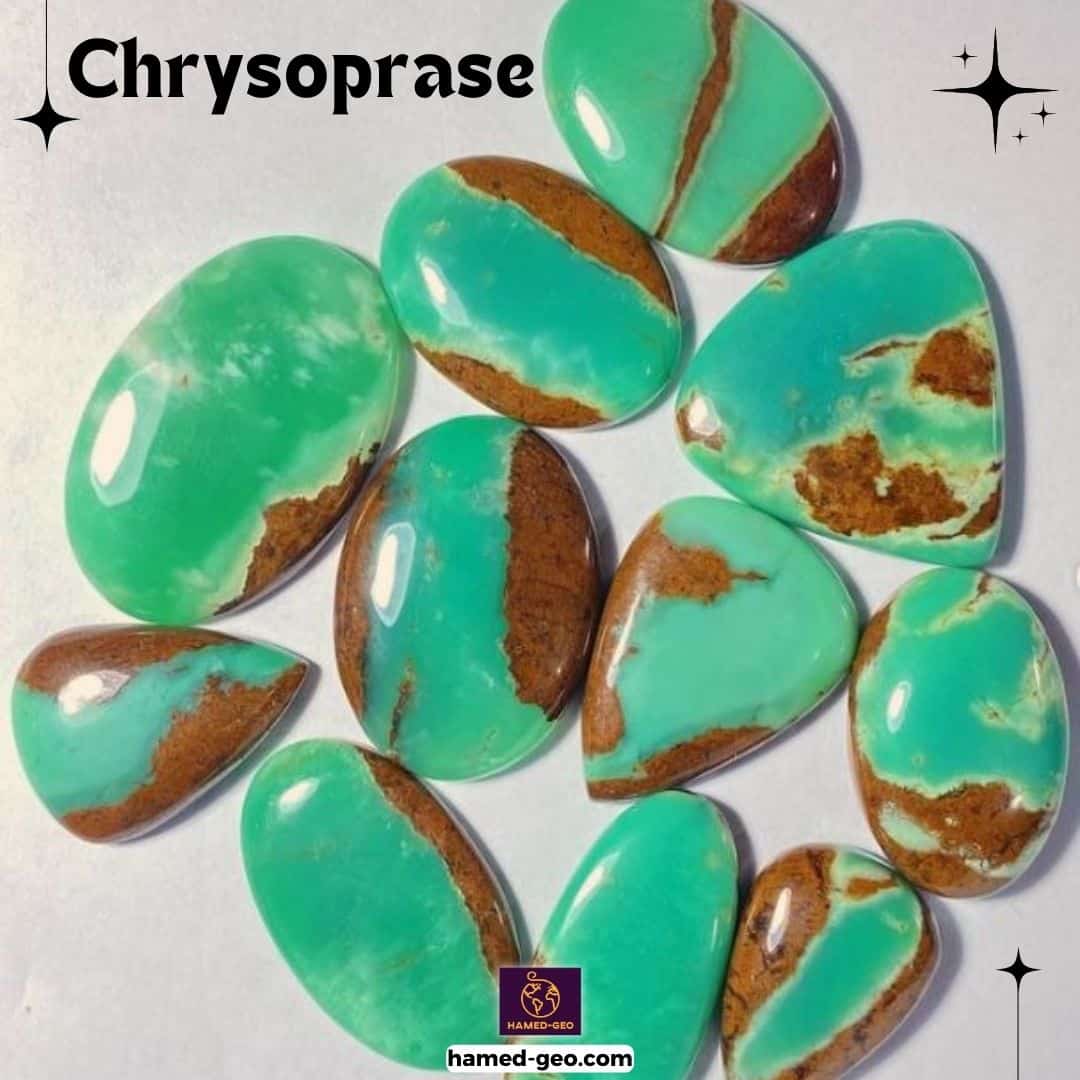
When rocks bearing Nickle metal weather, they deposit chrysoprase minerals. Chrysoprase is found in cracks, veins, and cavities. The overlying material compresses several layers, forming rocks containing nickel metal. These rocks are mined as chrysoprase. Where chrysoprase is found, peridotite, serpentinite, and dunite are usually present. Nickle is green in color hence giving chrysoprase greenish color. These green gems are the most valuable chalcedony variety after gem silica. It is scarce in the market; thus, it is not considered by the average jewelry shopper. The supplies of chrysoprase are limited and, therefore, not widely used. These gems variety are currently found in Australia. Its specific gravity is 3.97 to 4.0, while its Mohs hardness is 7.0. For its brilliant display, Egyptians, Greeks, and Romans used chrysoprase to manufacture jewelry, seals, ornament objects, and signets.
8. Chrysocolla
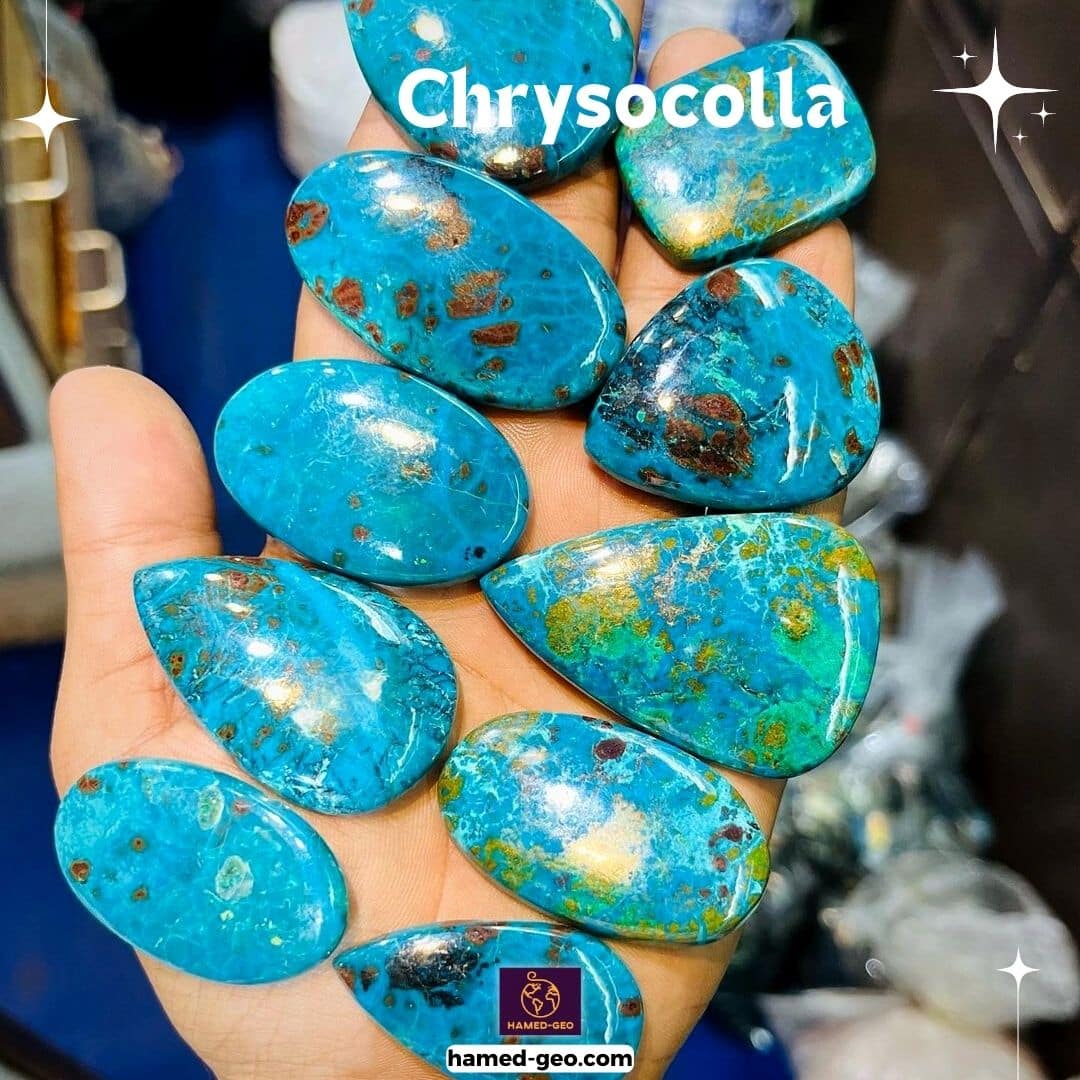
Chrysocolla is mainly found in copper mines formed due to decomposing copper minerals. They are commonly found in arid areas. It contains microscopic hydroxides of copper mineral, nebulous silica, and water. Its chemical formula is CuSiO3·2H2O. Water containing dissolved silica alters copper minerals in the outer parts of copper ore veins making the occurrence of chrysocolla as masses or crusts. Chrysocolla is blue-green. It has a hardness of 2.5 to 7.0 and a specific gravity of 2.15gm/cc. It is generally found as botryoidal, circular masses, crusts, or filled veins. Chrysocolla was used in certain cultures as a stone of gentle healing. It is also believed to be a piece of jewelry symbolizing fortune, prosperity, and luck. It is also an excellent choice worn to ease the difficulty in compelling creativity or feelings.
9. Agate
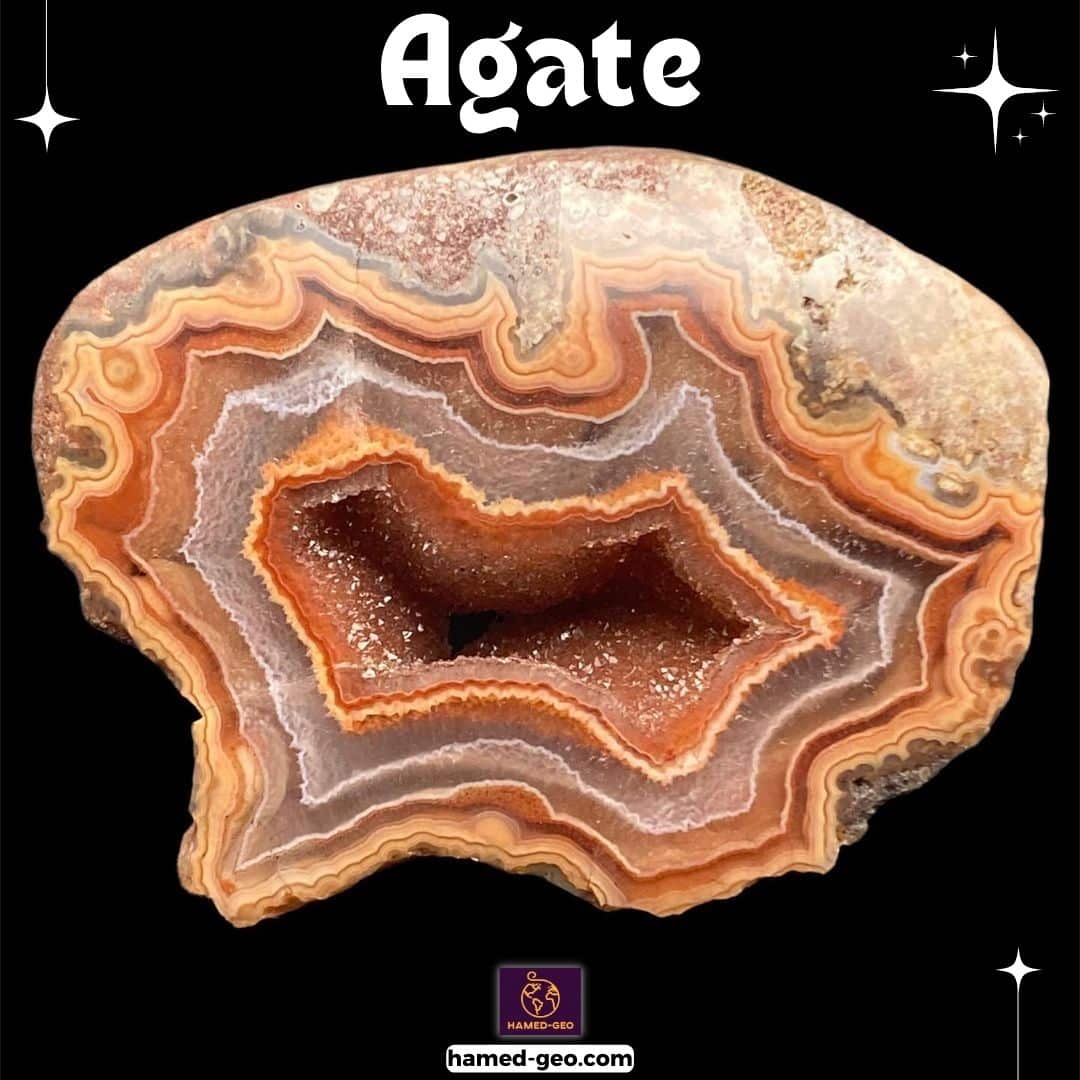
Agate is a type of chalcedony, a mineral in the quartz family. It is characterized by its banded patterns and colors, which can range from white to gray to black, as well as shades of blue, green, red, and yellow. Agates are formed when silica-rich fluids fill cavities in rocks, such as gas bubbles in volcanic rocks or spaces left by shells or other fossils. The silica then hardens and forms the agate.
Agates have been used for centuries for decorative and spiritual purposes. They were highly valued in ancient civilizations such as Greece, Rome, and Egypt, and were often carved into intricate designs. Today, agates are still used in jewelry, as well as in carvings, vases, and other decorative objects.
Agates are relatively common and can be found in many parts of the world, including the United States, Brazil, and Africa. Some of the most sought-after agates include Blue Agate, Dendritic Agate, Lace Agate, Moss Agate, and Fire Agate.
One of the interesting uses of Agate is in the field of geology, Agate is often used as a reference sample for other types of rocks because of its distinct banding.
It is abundantly evident that more gemstones are formed in sedimentary rocks even though they do not appear in large masses. Different gems found in sedimentary rocks result from the deposition of minerals in layers and are later compressed to form a gemstone. The gemstone is subsequently cut to the required sizes and polished to display the surface needed.
REFERENCES
Frondel, Clifford. “Secondary Dauphiné twinning in quartz.” American Mineralogist: Journal of Earth and Planetary Materials 30.5-6 (1945): 447-460.
Götze, J. “Chemistry, textures and physical properties of quartz—geological interpretation and technical application.” Mineralogical Magazine 73.4 (2009): 645-671.
Weaver, Charles E. “A discussion on the origin of clay minerals in sedimentary rocks.” Clays and clay minerals 5.1 (1956): 159-173.
Sylvester, Paul J. “Use of the mineral liberation analyzer (MLA) for mineralogical studies of sediments and sedimentary rocks.” Mineralogical Association of Canada Short Course 42 (2012): 1-16.
Schumann, Walter. Handbook of Rocks, Minerals, and Gemstones. Houghton Mifflin Harcourt, 1993.
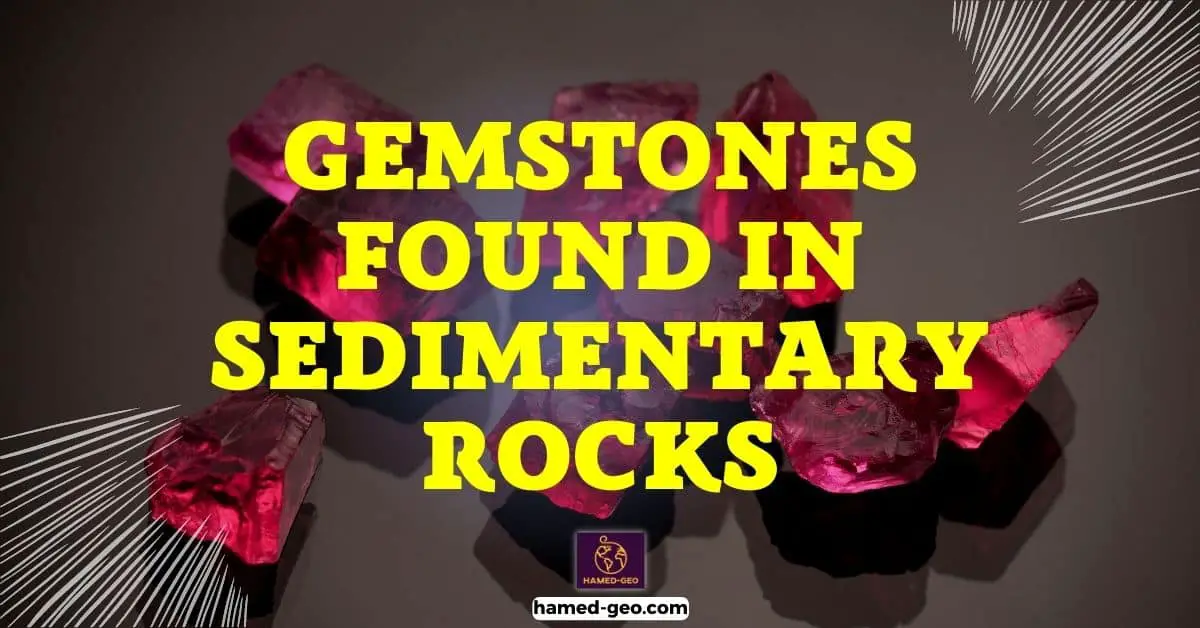
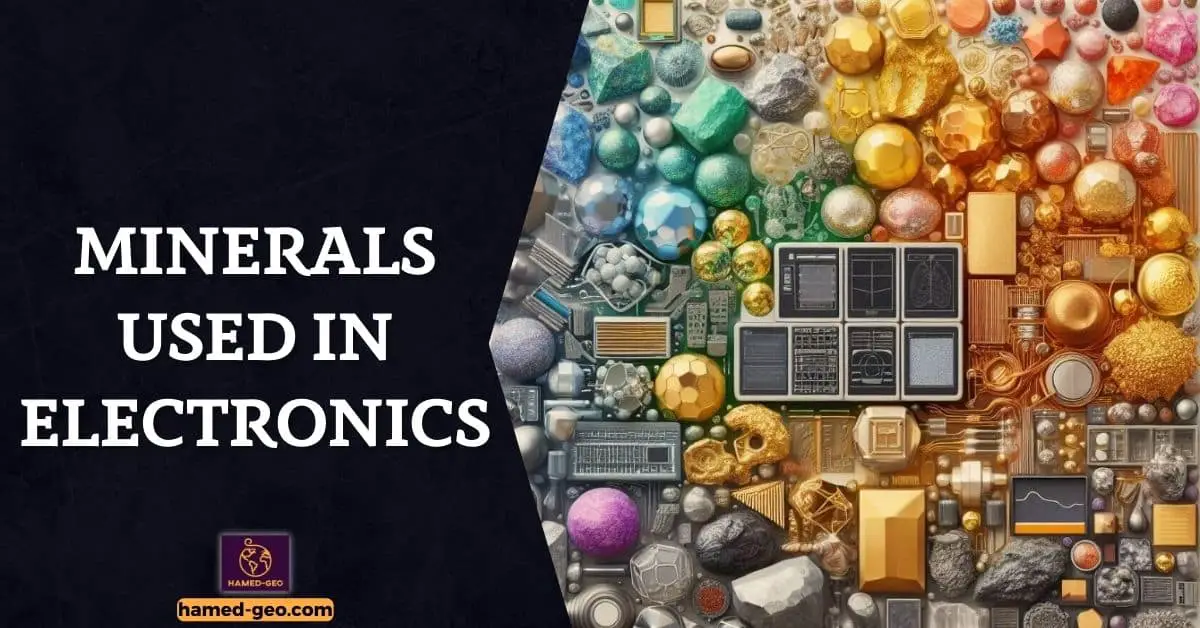
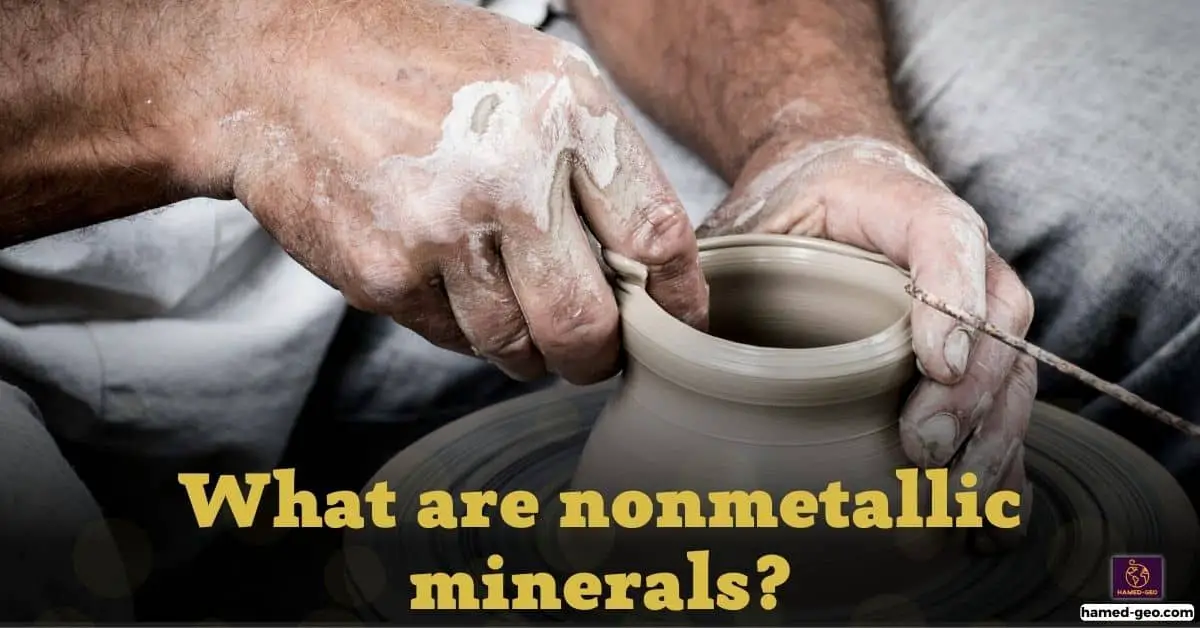

[…] Gemstone crystals must cool very slowly as fast cooling will produce very small crystals or glasses. Thus, cooling will occur deep on Earth. Large crystals are found in igneous rocks that are formed by the crystallization of magma which originated at great depths in the range of 950-450 Co .Here is a list of the most common gemstones found in sedimentary rocks. […]